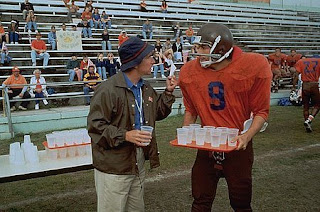Non-verbal communication is used regularly during sporting events. Many times the communication takes place between players but often times it is the non-verbal input from the coach on the sideline that will dictate the course of play in a game. In this post I will look into all of the hand signal and body gestures that are used in three of Americas most popular sport's: football, baseball, and basketball. In all three sports coaches pass information onto the playing field without speaking; this is important because the other team should not be able to find out your game plan.
FOOTBALL In football all the plays are call from the sideline. Both the offense and the defense rely on the coaching staff to tell them what play to run. It would be impossible for players to run to the sideline and talk to the coach then run back on the field and tell the team what the coach wants done. So what football teams do is they use body gestures and hand signals to communicate to the players on the field. There is an offensive captain and a defensive captain, so through some body gestures a coach can tell one guy what play to run and that player tells ten other players what to do on the next play and this all happens in less than 30 seconds.
During a football game, the coaching staff call almost every play in the game. Meaning that non-verbal communication is used prior to the start of every play. With the variety of plays a team has, the coach on the sideline may look quite animated sending a play to the team. A football coach will use hand signals, body gestures, wipes, touches, just about anything to let the team know which play to execute.
 BASEBALL
BASEBALLSome say the most boring part of watching baseball is the time between one pitch and the next. It seems like everyone just stands around waiting for a strikeout or a fly ball. What these people do not know is what is how much is happening during those thirty seconds that they can't hear and are not sharp enough to see. All over the field players are communicating with each other and with their coaches and nobody is saying a word.
One simple form of non-verbal baseball communication that the average fan does not see takes place every time a runner makes it to first base. The second baseman and the shortstop have to decide who will cover second base if the runner on first attempts to steal second base. To keep the opposing team from finding out who will cover, they do not just yell back and forth to each other. Most teams use the "open mouth closed mouth" system. When the shortstop shows the second baseman an open mouth the second baseman replies with a closed mouth meaning he will cover the base and vice verse.
The follow things all happen in those 30 seconds between almost every pitch and are all communicated through a series of hand signals:
1 - The pitcher and catcher are deciding what pitch to throw
2 - The shortstop and second baseman are choosing who will cover second base
3 - The manager is telling the third base coach what the offense is going to do
4 - The third base coach passes the information onto the hitter and any base runners
5 - A bench coach is changing the positioning of the outfielders and infielders
 BASKETBALL
BASKETBALLBasketball is a fast paced sport in which many decisions are made on the move. Whether to shoot the ball or pass it, who to pass the ball to, or who to defend. These questions are all answered by the players themselves on the court during the action. However, the coach does have control over some of the decisions that are made on the court. With a quick hand signal a coach can tell all five players on the floor what form of defense he wants to use. On the offensive side of the ball a coach can inform the team what offensive play to run by a hand signal to the point guard. The point guard then uses another signal to tell the other four players on the court what the play is.
The time-out is often used in basketball games by coaches to slow down the tempo of a game or to use strategic play calling. Other than the coach, it is crucial for the team leader to be able to send information to the rest of the team. He can instruct the team to set up a surprise defensive press to force turnovers, or using hand signals he can call for an ally-oop, or even something as simple as the pick and roll play. Your hands, your eyes, and your head motions are all important in each of these sports. Non-verbal communication is key to success and team chemistry leading to more wins and great sports experiences.









